Today was one of those transitional days where the bulk of the time is spent in transit from one stage of the trip to the next. In this case, we went from Hue (technically part of North Vietnam, though only just barely) back to Danang (on the other side of the North/South line, and the only operating airport in the region) and then on to Saigon (also known as Ho Chi Minh City, but Saigon is a more romantic name and the locals use it more than Ho Chi Minh City).
As I sit and take stock of the blogging situation, I realize (as I always do at this point in a big trip) that it's pretty dire. I mean, I've told you basically nothing about Hue (apart that ridiculous monkey business) and nothing at all about how we got there in the first place (motorcycles!), and there are gaps that I need to fill for Hoi An (bamboo coracles!), Bai Tu Long Bay (kayaks!), and Hanoi (John McCain's flight suit!). But there's no way I'm going to stay up all night to fill those gaps. Seriously, people, I've been averaging, like, six hours of sleep per night on this vacation -- which is less sleep than I normally get when I'm at home working! For now, I'll just stick to the daily highlights, and then go back and flesh things out later.
So. Back to Hue. Hue is a medium-sized city that straddles the Perfume River (which, sadly, is not perfumed) and was the capital of the Vietnamese Empire under the Nguyen Dynasty. It's not as crazy as Hanoi, nor as charming as Hoi An. It felt more modern than both of those towns, but also kind of bland. The primary attractions are the royal tombs and a couple of temples in the nearby countryside, and the citadel in the middle of town. (You'd think the food should be one of the draws, too, given that the imperial court really drove the development of Central Vietnamese cuisine, but it isn't. Apparently all the good Central Vietnamese restaurants are in Saigon -- we'll be hitting those up tomorrow.)
We explored the tombs and pagodas by motorbike yesterday, and I'll write about those separately. So we spent this morning visiting the citadel.
The citadel is a giant fortress in the middle of town surrounded by 10 kilometers of high walls and a moat.
Within the fortress is a second fortress called the Imperial Enclosure, which is where all the palaces and governmental buildings were. Most of these buildings were destroyed by natural disasters and heavy bombardments during the French and American wars. The government, with aid from UNESCO and other governments around the world, is in the process of reconstructing the complex. They've got a ton of work left to do, but the pieces they've finished so far are impressive.
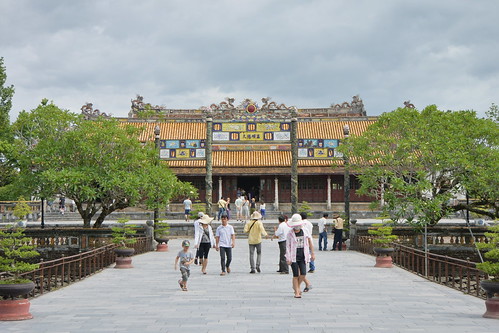 |
| The approach to the main palace, where the emperor held audience. |
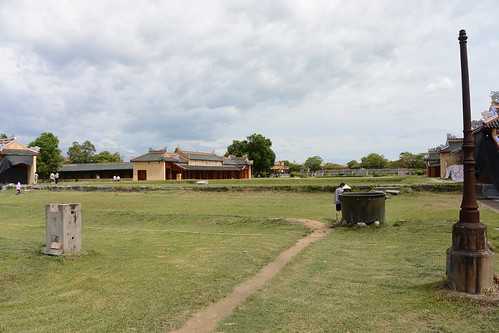 |
| Inside the Imperial Enclosure. Not much left. |
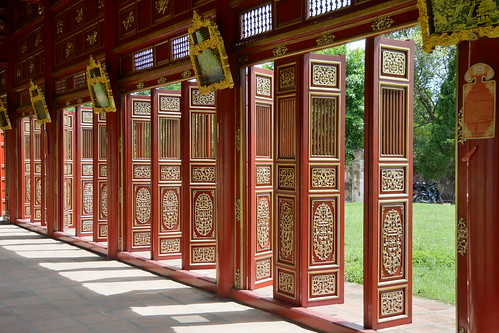 |
| Newly reconstructed gallery of gorgeous lacquered doors. |
And within
that, was yet
another fortress, called the Forbidden Purple City, which is where the emperor lived with all his wives and a bunch of eunuchs (fun!).
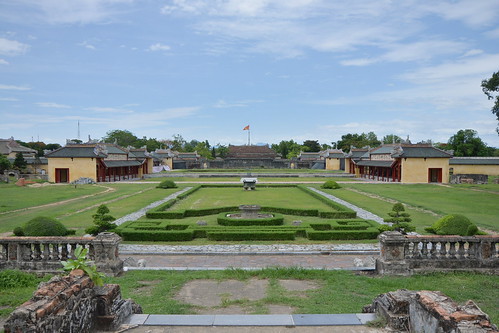 |
There literally was nothing left of the Forbidden Purple City. So here's the view from where
it used to be, looking back toward the main entrance. |
Also enclosed within the citadel walls are a couple of beautiful temple complexes dedicated to the emperors and the royal wives.
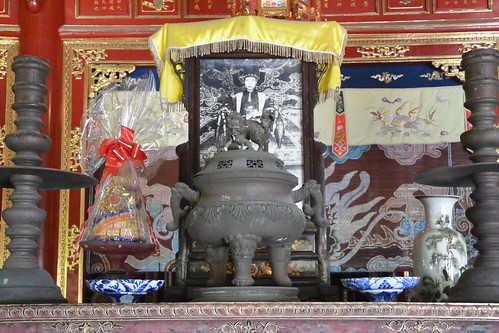 |
| Photo of the second-to-last emperor. |
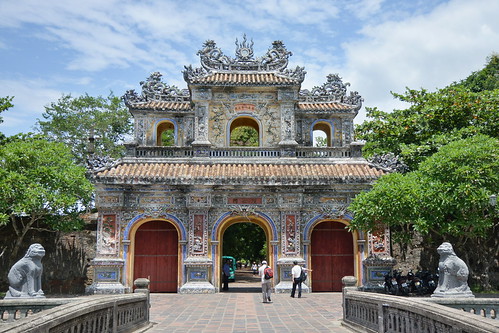 |
| The gate to the Imperial Enclosure. |
By the time we were done exploring the citadel, we were both essentially walking puddles of sweat. The clouds that had blocked the sun for the past two days had blown away overnight, and the day was as clear and bright as could be. While the humidity was blessedly lower than before, the tropical sun beat down with a vengeance. Our clothes (at least mine) were as wet as if we'd just crawled out of a swimming pool -- we wanted nothing more than a cool shower and a glass of lemonade before climbing into the air conditioned car to Danang.
So back to the hotel . . . but on our way, we couldn't resist having a little Commie moment in front of the memorial.
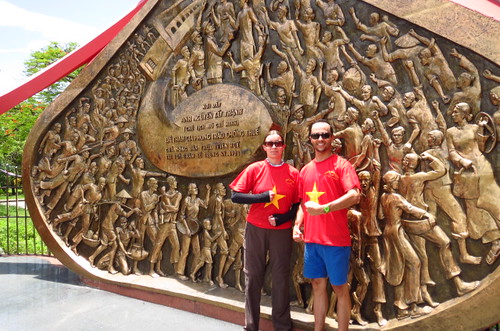 |
| Unite, comrades! |
Back at the hotel we succeeded in getting both the shower and the lemonade that we'd hoped for (the girls at the front desk were blessedly liberal in their dispensing of lemonade). That left us enough time to try out another restaurant for lunch -- this time we went for barbecue.
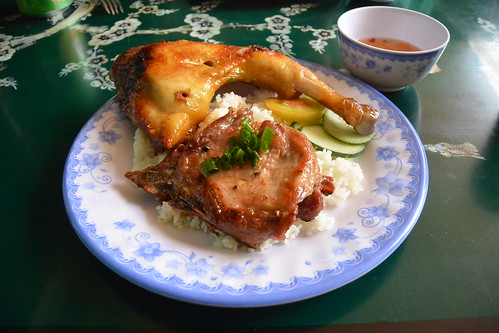 |
| Grilled chicken and pork chop |
Our car arrived at 1:00pm to take us to Danang. We'd hired a private driver so that we could take the road over Hai Van Pass, rather than take a bus and be required to go through the tunnel. The Hai Van Pass road is by far the more scenic route, passing by gorgeous beaches and views over the coast.
It's also got a fair amount of historical significance. This road was the primary link between North Vietnam and South Vietnam, and so it was strategically important for the French and the Americans, both of whom built fortifications at the top of the pass.
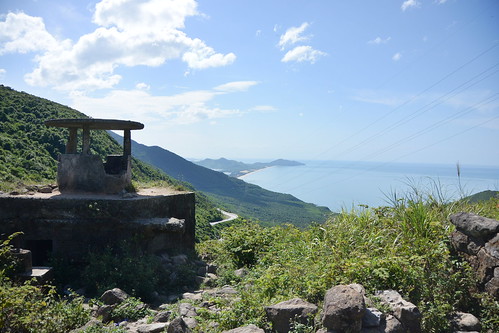 |
| The view toward the North. |
 |
| Southern view: Danang city and Monkey Hill. |
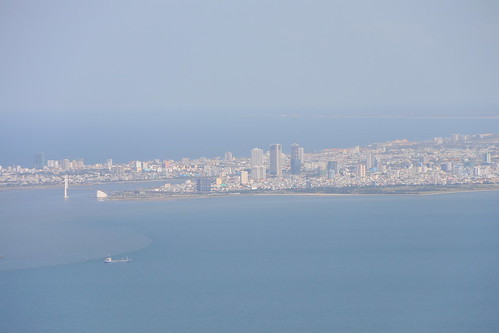 |
| Danang |
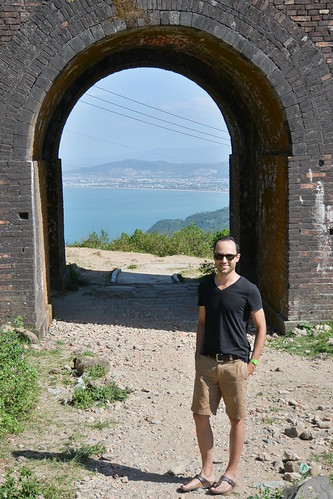 |
| Moi, under the arch of the French tower. |
We arrived at the airport in Danang well in time for our departure. It's a nice, new airport, and I continue to be amazed at how well they move people through the security lines. I kid you not, no security line that I've gone through in Vietnam has taken more than about 5 minutes to get through. It could be that they're not that rigorous (I definitely smuggled in a bottle of water despite the signs that purported to ban all liquids), but still. The US airports and airlines could learn a thing or two from the Vietnamese.
We landed in Saigon a little after 7:00pm; our driver was waiting for us at the exit. The drive through town to the hotel proved that Saigon's reputation as the most modern city in Vietnam was right. You can tell you're in Vietnam -- the motorbikes, the countless little shops, the conical hats -- but it's a more modern version than what we've seen elsewhere. More of the shops are glassed-in store fronts, rather than open-air stalls on the sidewalk; more of the eating establishments are actual restaurants with full-sized chairs, rather than little plastic stools. Traffic rules and stop-lights actually mean something. It feels like a sophisticated big city in a way that Hanoi does not.
By the time we had checked into the hotel and gotten our bearings, it was late enough that all we really wanted to do was get some dinner and go to bed. Fortunately, our hotel is within walking distance from Saigon's night market, which is an open-air market that runs until midnight. Neville, the Aussie who ran the food tour in Hoi An, had recommended that we try one of the food places there. His instructions were fuzzy -- "Look for a place grilling fish, with lots of smoke." -- and we weren't sure that we'd be able to find the place. But, sure enough, after a few minutes of wandering we saw clouds of smoke ahead, and the source of said smoke was a row of grills with all sorts of fish.
 |
| This is where the magic happens |
We sat down and ordered some refreshing drinks . . .
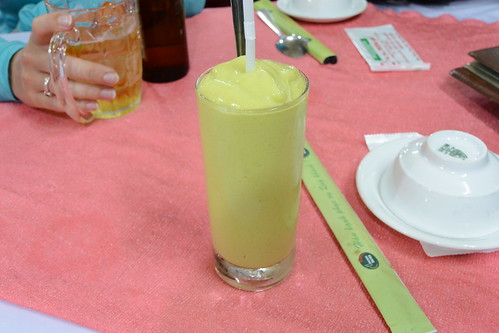 |
| I had an avocado milkshake |
and fried spring rolls . . .
barbecued shrimp . . .
and barbecued red snapper.
All of which was amazing. Especially the snapper. I do not have words to describe how good that fish was -- so smooth and moist, with perfectly complementary flavors from whatever barbecue sauce or rub they put on the fish. Hands down the best red snapper (probably even the best fish, of any sort) that I've eaten. It is the standard against which all future fish will be judged.















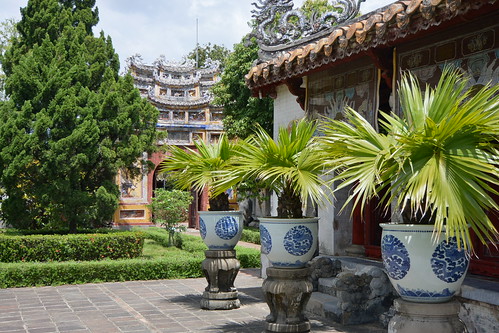
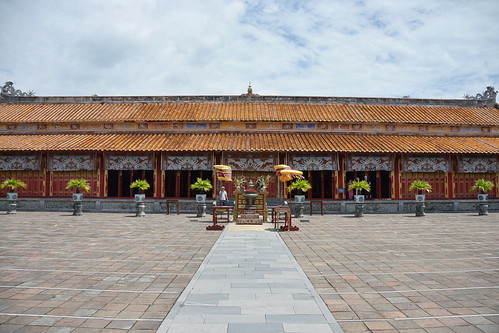
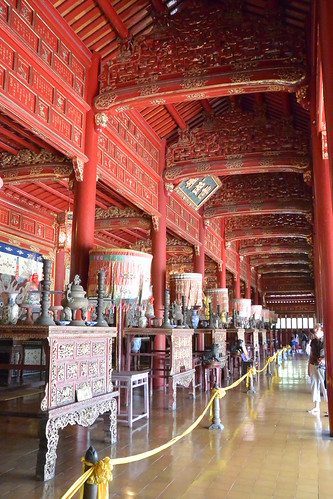
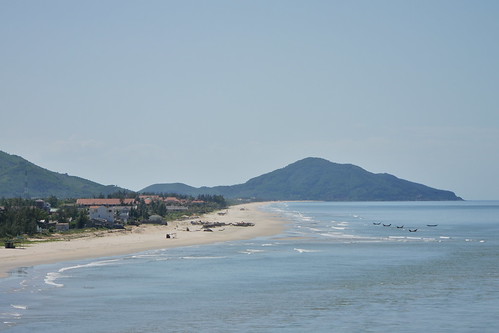
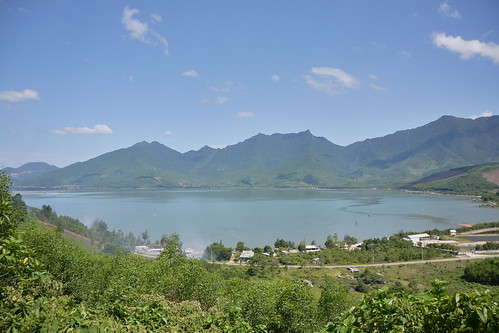

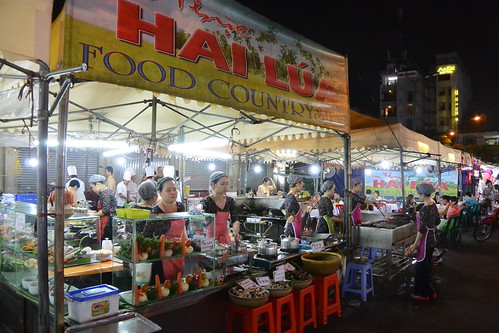
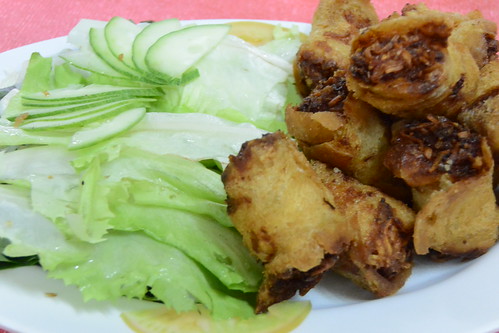
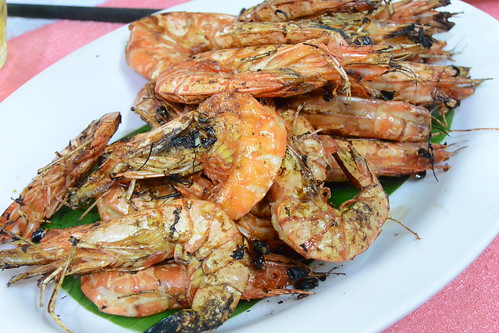
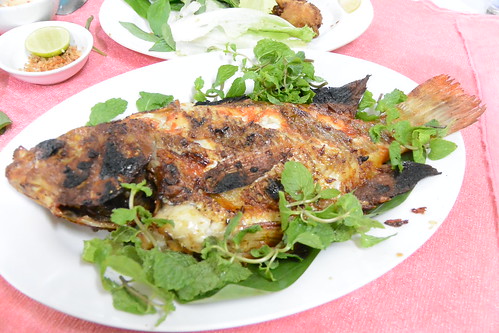
3 comments:
I think all food should be served sans heads, fins and legs, but that's just me. I do want to hear about the typhoon. What kind of souvenirs will be coming home with you this time? Lady
Fish-smish...I want to know about that avocado milkshake. Yes or no?
The avocado milkshake is a definite yes. I've made them before at home -- just blend together vanilla ice cream and avocado. I also love avocadoes with bananas.
Post a Comment